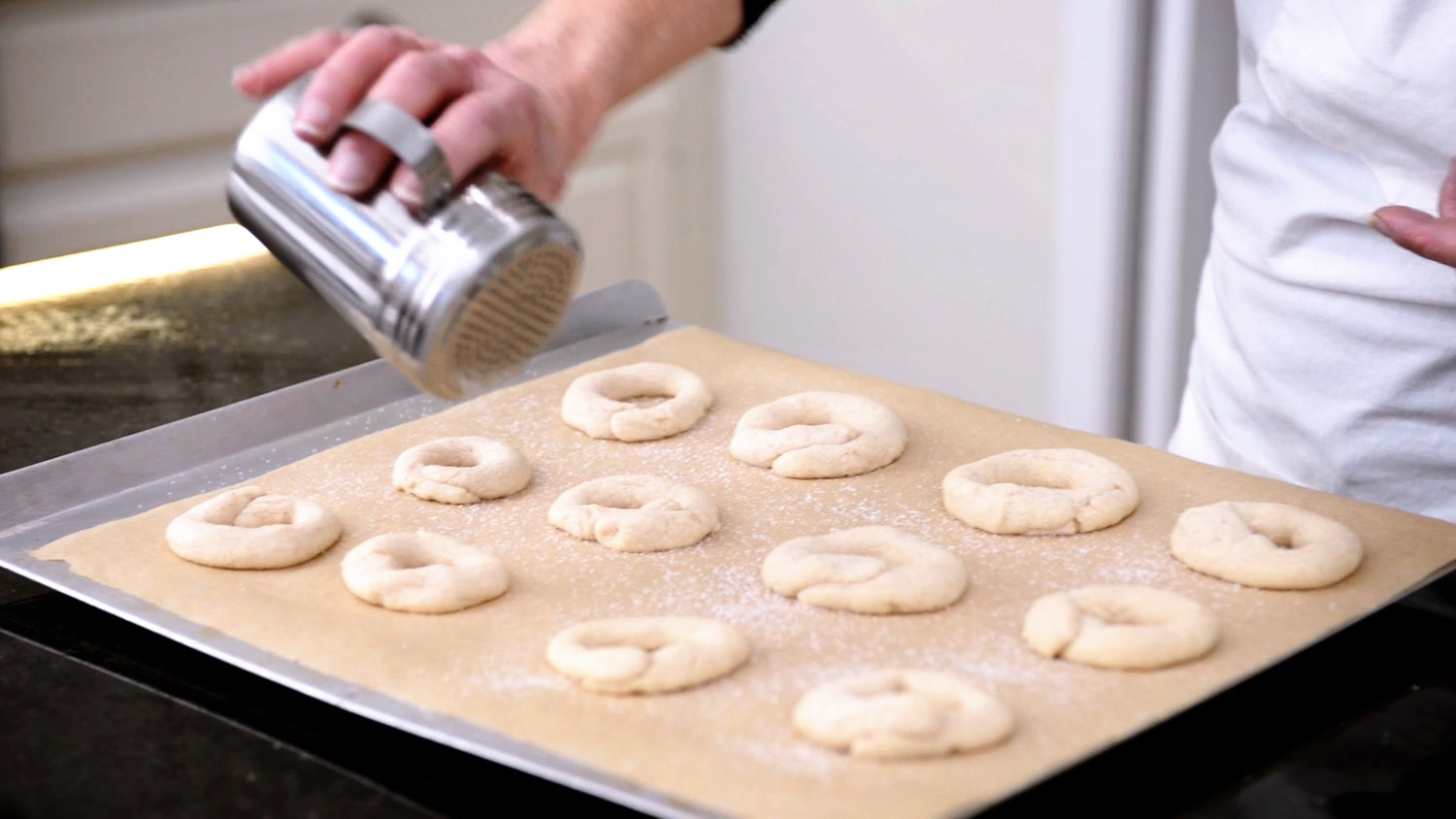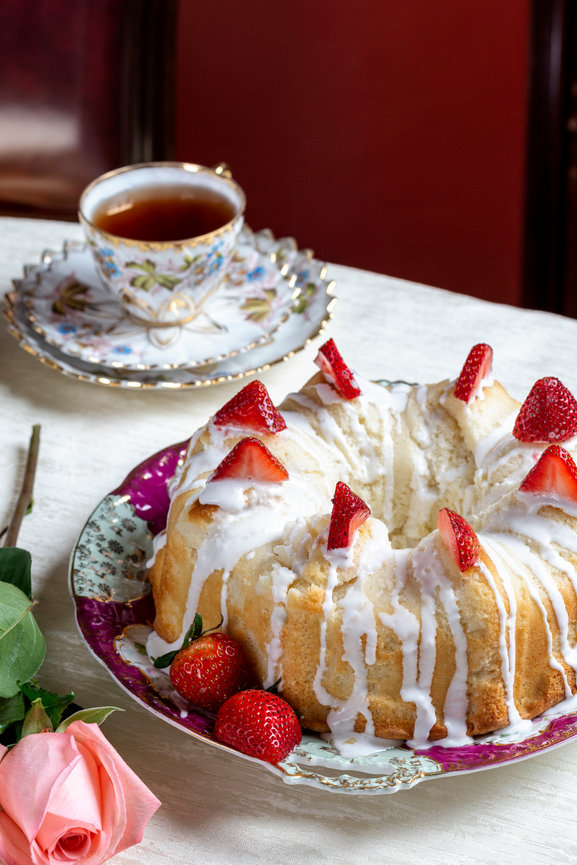Mom's Lemon Star Cookies
Wednesday, January 17, 2018 | By: Becky Diamond
Share
Lemon is one of the most underrated flavors for sweets, often eclipsed by fan favorites chocolate and vanilla. On its own, lemon is sharp and acidic, but paired with sugar; it becomes a delightful sweet-tart combination. Cooks have been flavoring custards, puddings, and pies with lemons and other citrus fruits since medieval times. The acidic lemon was valued for both its flavor as well as its preservative effect, which made it a sought-after ingredient for many recipes. An expensive commodity, lemons would be preserved by drying or made into a liquid flavoring or essence like our baking extracts today.
In Colonial America, lemon was one of the most popular flavor ingredients. As a busy port city, Philadelphia received an abundance of tropical foods, including citrus fruits such as lemons and oranges from Portugal. In addition, several wealthy estates throughout the city featured hothouses that grew lemons and other fruit. One of the most famous was Lemon Hill, the country residence of Henry Pratt, Esq., which was located on the Schuylkill River, not far from the Fairmount water works. The site included over two hundred square feet of greenhouse and hothouse growing space, said to be “unrivaled in the Union.” In additional to rare and fragrant flowers and tropical plants, numerous fruit trees such as orange, banana, guava, cherimoya, plantain, and of course lemon, flourished there in the warm, humid environment. Merchant and banker Stephen Girard was another wealthy Philadelphian who was known to dabble in hothouse gardens. The small greenhouse on his country estate was stocked with lemons, mandarin oranges, and many other kinds of fruit.
As many cooks know, adding lemon to a recipe brings out the flavors of the other ingredients and makes everything taste fresher and brighter. Although sour by itself, when paired with butter, sugar, and eggs it results in a product that tastes tangy and pleasantly astringent. As noted by confectioner and restaurateur James Parkinson, American confectioners creatively used lemon to concoct a variety of delicious desserts, including the lemon pudding and ice cream on his Thousand Dollar Dinner menu. In fact, In the 1840s and 1850s, lemon was one of the most popular flavors of ice cream, along with vanilla, strawberry, and pineapple.
Lemon was also a beloved cookie flavoring, sometimes used interchangeably with rose-water or orange blossom water, such as Mrs. Goodfellow’s famous jumbles. When looking through the book of old family recipes lovingly made for me by my mom, I saw an intriguing lemon cookie recipe called “Mom’s Lemon Star Cookies” from her Grandmother Lawrence. According to my mom, her grandmother used to make them all the time. After giving them a try, I can see why! The recipe is simple, basically a sugar cookie recipe swapping lemon extract (or essence) for vanilla. Interestingly, I found the same exact recipe in a 1919 issue of Good Housekeeping. It's very likely this is where her grandmother saw it. That recipe says to ice them and scatter with chopped walnuts, but the recipe handed down in my family has no decorating suggestions. I decided to frost some of mine with the icing recipe below. I also simply sprinkled confectioners sugar on some of the cookies, which gave them a lovely speckled look.
In Colonial America, lemon was one of the most popular flavor ingredients. As a busy port city, Philadelphia received an abundance of tropical foods, including citrus fruits such as lemons and oranges from Portugal. In addition, several wealthy estates throughout the city featured hothouses that grew lemons and other fruit. One of the most famous was Lemon Hill, the country residence of Henry Pratt, Esq., which was located on the Schuylkill River, not far from the Fairmount water works. The site included over two hundred square feet of greenhouse and hothouse growing space, said to be “unrivaled in the Union.” In additional to rare and fragrant flowers and tropical plants, numerous fruit trees such as orange, banana, guava, cherimoya, plantain, and of course lemon, flourished there in the warm, humid environment. Merchant and banker Stephen Girard was another wealthy Philadelphian who was known to dabble in hothouse gardens. The small greenhouse on his country estate was stocked with lemons, mandarin oranges, and many other kinds of fruit.
As many cooks know, adding lemon to a recipe brings out the flavors of the other ingredients and makes everything taste fresher and brighter. Although sour by itself, when paired with butter, sugar, and eggs it results in a product that tastes tangy and pleasantly astringent. As noted by confectioner and restaurateur James Parkinson, American confectioners creatively used lemon to concoct a variety of delicious desserts, including the lemon pudding and ice cream on his Thousand Dollar Dinner menu. In fact, In the 1840s and 1850s, lemon was one of the most popular flavors of ice cream, along with vanilla, strawberry, and pineapple.
Lemon was also a beloved cookie flavoring, sometimes used interchangeably with rose-water or orange blossom water, such as Mrs. Goodfellow’s famous jumbles. When looking through the book of old family recipes lovingly made for me by my mom, I saw an intriguing lemon cookie recipe called “Mom’s Lemon Star Cookies” from her Grandmother Lawrence. According to my mom, her grandmother used to make them all the time. After giving them a try, I can see why! The recipe is simple, basically a sugar cookie recipe swapping lemon extract (or essence) for vanilla. Interestingly, I found the same exact recipe in a 1919 issue of Good Housekeeping. It's very likely this is where her grandmother saw it. That recipe says to ice them and scatter with chopped walnuts, but the recipe handed down in my family has no decorating suggestions. I decided to frost some of mine with the icing recipe below. I also simply sprinkled confectioners sugar on some of the cookies, which gave them a lovely speckled look.
My great-grandmother's recipe:
Mom’s Lemon Star Cookies
Mom’s Lemon Star Cookies
- 1 cup sugar
- ¾ cup butter, softened
- 3 eggs
- 3 ½ cups flour
- 3 tsp baking powder
- ½ tsp salt
- 1 tbsp lemon extract or flavoring
- Preheat oven to 375F
- Mix butter and sugar together until creamy.
- Beat in the three eggs.
- Sift dry ingredients together, and slowly add to wet ingredients.
- Stir in lemon flavoring (and a half tsp of lemon zest for extra zing if desired).
- Roll out and cut into star shapes. If not firm enough, refrigerate the dough first.
- Decorate with icing recipe below, (and scatter with chopped walnuts if desired) or simply sprinkle with confectioners sugar
- 1 egg white
- 2 cups sifted confectioners’ sugar
- 1 Tsp. lemon juice






Leave a comment
0 Comments